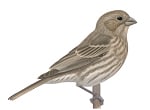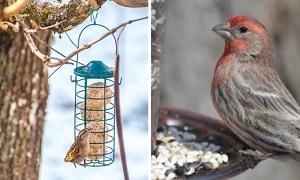House finches and house sparrows look incredibly similar. They are both small, striped, brown birds that are common in urban areas.
So how can you quickly tell apart a house finch vs house sparrow? The two species have noticeable differences in size, body shape, beak shape, color, diet, location, and flight and perching patterns.
Here is an identification guide outlining the differences between the two birds:
|
House Finch |
House Sparrow |
|
| Size | Smaller and more delicate:
– Weight: 16 g – 27 g |
Larger and bulkier:
– Weight: 14 g – 32 g |
| Body shape | Flat head with a shorter, notched tail.
Short, dark grey legs |
Rounded body, with a rounded head and tail with a relatively straight edge
Long, pale pink legs |
| Beak shape | Thicker and sharper than sparrows’, tend to be grayish | More conical in shape, can be black or yellow |
| Color | Generally lighter-colored, plainer, and less patterned. Flanks have brownish streaks | Generally darker, with more black and dark browns on their back and wings. |
| Diet | Grains, seeds, flowers, buds, and berries | Mostly seeds, sometimes insects and scraps |
| Location | Originally from the west coast of North America, including parts of the US, Mexico, and Canada. | Originally from Europe, Asia, and North Africa. |
| Flight and Perching Patterns | Comfortable flying long distances high over treetops | Tend to fly lower and stay close to foliage for cover. |
Table of Contents
The Difference Between Sparrow and Finch
As a general rule, big birds such as hawks and eagles are more straightforward to tell apart than smaller birds.
Adding to the confusion is the fact that there are so many small brown bird species! To make things a little simpler, bird lovers have simply dubbed them all “LBJs,” which stands for “Little Brown Jobs” (or Little Brown Birds).
Two similar small brown birds are the common brown finch and house sparrows. They both have streaked feathers, a conical beak, and a primary diet of seeds.
The differences become apparent when looking at sparrow and finch pictures next to each other. The true challenge is identifying one of them standing by themselves!
So here is a quick guide describing each of the little birds and tips for identifying female house finch vs sparrow:
1. Size and Body Shape
There is some difference in the size of the two birds–but only very slightly. Their differences in weight are mere grams apart, and sparrows, on average, are just an inch longer than finches.
Still, should you have the opportunity to observe the two birds next to each other, the rounder, bulkier bird will likely be the house sparrow. The smaller, more delicate bird will likely be the house finch.
Aside from that, house sparrows have rounded heads, tails with a relatively straight edge, and long, pale pink legs. These are very different from the house finches’ flatter heads, short notched tail, and short, grayish legs.
2. Beak Shape
Another way to determine which species you are looking at is by comparing finch vs sparrow beak.
Finches tend to have thicker, sharper beaks compared to house sparrows’ more conical, rounded beaks. Their colors are different, too: finches have gray beaks while sparrows have black or yellow beaks, depending on their age and maturity.
The difference in their beak shapes has to do with their seed preferences. Finches have sharper beaks to break open finer seeds, while sparrows tend to prefer larger seeds and grains.
Though almost impossible to see, sparrows also have an extra bone in their tongue that helps them eat their seeds!
3. Color
House sparrows look like female finch birds with their brown, streaked bodies. Upon closer inspection, there are still some noticeable differences, though.
Female house finches in general are grayer and plainer-looking with no distinct patterns except for some brown streaks on their flanks.
Pictures of house sparrows will show that they come in darker shades of brown with noticeable patterns on their faces in chestnut, gray, and whitish colors.
Why the emphasis on “female house finches”? Because male house finches are easy to tell apart with their red head and breast!
Interestingly, though, the exact shade of each male house finch can vary depending on their diet.
4. Diet
Aside from the mentioned preference of finches for smaller seeds and sparrows for bigger seeds, it can be tricky to identify which species you are seeing by simply looking at your bird feeder.
One easy thing to remember is that house finches are practically strictly vegetarian. So if you spot a bird gulping down some insects, that’s a sparrow!
5. Location
While house sparrows and house finches can be found all over urban areas in North America, they come from different places.
House finches are originally from the continent’s west coast, found in parts of the US, Canada, and Mexico. They have since spread all over the east coast as well.
House sparrows are native to Europe and Asia, though they are now almost everywhere. The sparrow species native to the US is the song sparrow, which is much easier to tell apart from finches.
6. Flight and Perching Patterns
Last but not least, house finches and house sparrows differ in their flight and perching patterns.
House finches fly higher over longer distances, while sparrows like to fly shorter distances closer to the ground.
Meanwhile, while perching, house finches tend to stand taller with their tails angled down, while sparrows raise their tails or hold them horizontally.
Frequently Asked Questions
Is there such a thing as a red headed sparrow bird?
Some people online have asked about a sparrow with redhead and chest. Is there such a thing as a red sparrow?
No – there is no such thing as a male red headed sparrow. If you spot one and find yourself wondering if you are seeing a red headed sparrow vs house finch, it’s a male house finch.
Conclusion
Not sure if you’re seeing a house finch vs house sparrow in your backyard? Don’t worry. Even the most experienced bird watchers get confused sometimes!
Whatever little brown bird may be hopping around your yard eating your seeds, it’s best not to try to touch it! While finches are known to be friendly, house sparrows can be aggressive to humans.
Remember, it’s always better to be safe than sorry and simply appreciate your avian visitors from a distance.
Read more:
- Cooper’s hawk vs sharp shinned hawk: What is the difference?
- The difference between robin and oriole.

George and I became friends after a birdwatching trip with our new group. And we have been enjoying every adventure together. When he told me the idea of establishing a site that shares our experiences and fun, I immediately agreed. After trials and errors, here we have Thayerbirding.




















